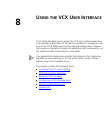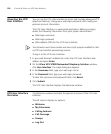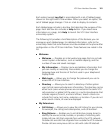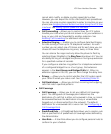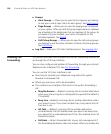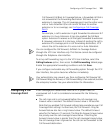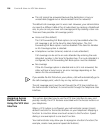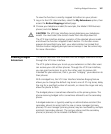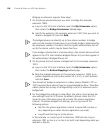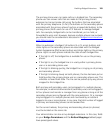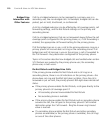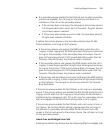
106 CHAPTER 8: USING THE VCX USER INTERFACE
■ The call cannot be answered because the destination is busy or
unreachable (logged out or disconnected from the network).
The default call coverage point is voice mail. However, your administrator
can specify a different default for all subscribers by creating a Predefined
rule, or you can set your own call coverage point by creating a User rule.
There are three possible call coverage points:
■ Voice mail (the default)
The Call Forwarding Fall Back option can only be enabled when the
call coverage is set to the Send to Voice Mail option. The Call
Forwarding Fall Back option must be disabled if the Send to Number
or No Coverage option is selected.
■ A telephone number (internal, external or auto attendant)
Call coverage can be set to an auto attendant by entering the auto
attendant number in the Send to Number box. If an auto attendant is
configured, the Call Forwarding Fall Back option must be disabled.
■ No coverage
If the No Coverage option is selected and a call is not answered, the
caller will hear a busy tone or an error message depending on the
reason for the unanswered call.
If you enable Do Not Disturb on your phone, calls will automatically go to
the call coverage point, which may or may not be voice mail.
The call coverage point must be set through the VCX User Interface (or
the Administrator Interface). It cannot be set through the Telephone User
Interface.
Assigning Access
Button Functions
Using the VCX User
Interface
This section describes how to use the VCX User Interface to view, and
possibly modify, the VCX features associated with the Access buttons on
your telephone.
When a VCX system is configured, your administrator assigns (maps)
default functions for the Access buttons on your telephone. Mapping a
function to a button allows one-touch access to that function. Speed
dialing is one example of a one-touch function.
Your administrator may allow you to reprogram a button’s function (for
example, create more personal speed dial buttons).




